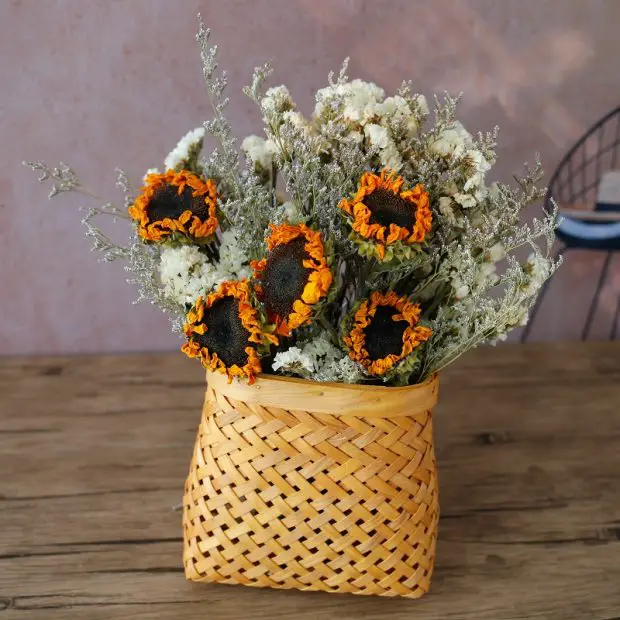Drying sunflowers is a rewarding way to preserve their natural beauty. Fresh sunflowers bring vibrant color and charm to gardens and homes. However, blooms fade quickly if not preserved properly. Drying maintains their visual appeal and allows enjoyment throughout the year.
Preserved sunflowers are ideal for home décor, wreaths, and craft projects. They also make thoughtful gifts or seasonal decorations. Understanding the drying process ensures flowers retain shape, color, and texture. Different methods suit various purposes, from hanging stems to silica gel preservation. By following expert techniques, gardeners and flower enthusiasts can enjoy long-lasting blooms and create stunning arrangements.
Choosing the Right Sunflowers

Selecting the right sunflower variety is essential for successful drying. Large, sturdy blooms with thick petals retain their shape and color better. Varieties like Giant Russian or Lemon Queen are ideal for hanging or display purposes. Smaller blooms may require delicate handling and specialized techniques to preserve their structure.
When choosing flowers, inspect stems and leaves carefully. Strong, healthy stems support hanging during drying. Avoid flowers with wilted petals or signs of disease, as these may deteriorate quickly. Harvest blooms at their peak, when petals are fully open but not over-mature, to ensure maximum vibrancy. Timing affects both color retention and structural integrity.
Consider the intended use of dried sunflowers. Tall varieties are perfect for large bouquets and statement arrangements. Medium or dwarf types work well for wreaths, crafts, or table displays. Selecting flowers with consistent size and color provides a uniform look in arrangements. By choosing healthy, well-formed sunflowers, gardeners ensure long-lasting blooms that retain visual appeal and texture. Thoughtful selection simplifies the drying process and enhances the final result for decorative or practical use.
Timing Your Harvest for Optimal Drying
Harvesting sunflowers at the right stage ensures long-lasting preservation. Select blooms that are fully open but not over-mature. Avoid wilted or discolored petals, which may deteriorate during drying. Strong stems are crucial to support the flower’s weight while drying.
Environmental conditions also affect timing. Harvest in the morning after dew evaporates to reduce moisture content. Avoid rainy or excessively humid days, as damp flowers are prone to mold. Timing impacts both color retention and petal firmness. Harvesting too late can result in browned or brittle petals that are difficult to preserve.
Observing bloom stage and weather conditions ensures optimal results. Small adjustments in timing can improve the quality of both air-dried and silica gel-dried flowers. Planning harvest according to bloom size, stem strength, and environmental factors maximizes success. Correct timing preserves vibrant colors, maintains structural integrity, and extends the decorative life of dried sunflowers.
Preparing Sunflowers for Drying
Proper preparation ensures sunflowers dry evenly and maintain their shape. Begin by selecting fully opened, healthy blooms. Avoid flowers with wilted petals or damaged leaves, as these can compromise drying quality. Trim excess foliage from stems to reduce moisture and prevent mold formation.
Next, clean the stems gently if dirt or debris is present. Avoid washing flowers, as excess water can promote mildew. Decide on the drying method before harvesting, as stem length and bloom size may affect technique. Small bunches of flowers ensure proper airflow and prevent overcrowding.
Finally, handle flowers carefully to prevent bruising or bending. Grouping blooms in small, evenly spaced bunches promotes uniform drying. Remove leaves that will sit in enclosed areas, as they may retain moisture. Well-prepared sunflowers are more likely to retain vibrant color, structural integrity, and texture throughout the drying process. Preparation is key to achieving long-lasting, beautifully preserved blooms suitable for arrangements, crafts, or home décor.
Choosing the Right Tools and Materials
Selecting the proper tools is essential for successful sunflower drying. Sharp pruning shears help cut stems cleanly and prevent damage. Floral wire supports long stems during hanging or arrangements. String or twine is useful for bundling blooms and suspending them in a ventilated space.
Absorbent paper or parchment is necessary when pressing flowers. It prevents petals from sticking and allows even moisture absorption. For silica gel drying, airtight containers or jars are required. Containers must be slightly larger than the blooms to avoid crushing petals. Silica gel should completely cover petals for effective drying.
Additional materials enhance both preservation and convenience. Gloves protect delicate petals during handling. Silica gel packets control humidity in storage containers. A cool, dry, ventilated area reduces mold risk. Having all tools and materials prepared before starting ensures the process runs smoothly. Proper preparation simplifies drying, preserves structure, and results in beautifully maintained sunflowers suitable for crafts, gifts, or long-lasting home décor.
Drying Methods
There are several effective methods for drying sunflowers, each suited for different purposes. Hanging flowers upside down is a traditional and simple technique. Tie stems in small bunches and hang them in a cool, dry, and well-ventilated area. This orientation preserves the shape and prevents petals from bending.
Air-drying works best in low-humidity environments. Ensure flowers are not exposed to direct sunlight, which can bleach colors. Rotate bunches occasionally to encourage even drying. Patience is essential, as large blooms may take two to four weeks to dry completely. Proper airflow reduces the risk of mold and ensures uniform preservation.
Another method involves silica gel, which accelerates drying for delicate or smaller blooms. Place flower heads in a container filled with silica gel, covering petals completely. Check flowers regularly to prevent over-drying, which can make them brittle. Silica gel helps maintain color vibrancy and structural integrity, making it ideal for craft projects or arrangements. Choosing the right drying method ensures beautiful, long-lasting sunflowers suitable for decoration, gifts, or creative projects.
Combining Drying Methods for Best Results
Using multiple drying methods can yield superior results. Hanging and air-drying is ideal for large, sturdy blooms. This technique preserves shape while allowing moisture to escape evenly. Silica gel works best for small or delicate flowers, maintaining vibrant color and structure.
Combining methods allows customization according to bloom type and intended use. Some gardeners use air-drying for display flowers and silica gel for crafting projects. Pressing is excellent for flat arrangements or artwork. Integrating these methods reduces the chance of mold and prevents color loss.
Planning method selection based on flower size and purpose ensures success. Combining techniques also provides flexibility for different projects. Strategic use of multiple methods maximizes preservation quality, ensuring flowers remain visually appealing and durable. Properly dried sunflowers can be used in long-lasting arrangements, creative crafts, and decorative displays.
Using Silica Gel
Silica gel is an effective method for preserving delicate sunflower blooms. It helps maintain vibrant colors and structural integrity. This method is ideal for small or intricate flowers that may not hold up well with air-drying or hanging.
Begin by choosing a container slightly larger than the flower head. Pour a layer of silica gel at the bottom and place the bloom gently on top. Cover the petals completely with more silica gel, ensuring even contact without crushing. Seal the container to prevent moisture from entering.
Check the flowers regularly during the drying process. Depending on size and moisture content, drying may take several days to a week. Once completely dry, carefully remove the sunflower and gently brush off excess silica gel. This technique preserves natural shape, texture, and color, making flowers suitable for crafting, wreaths, or framed arrangements. Using silica gel ensures sunflowers remain beautiful and durable, providing long-lasting decorative value.
Hanging and Air-Drying
Hanging sunflowers upside down is a traditional and effective method for long-lasting preservation. Start by tying stems into small, evenly spaced bunches. Choose a cool, dry, and well-ventilated area away from direct sunlight to prevent color fading.
Ensure proper airflow around each bunch to reduce the risk of mold. Rotate flowers occasionally to promote even drying. This method works best for large, sturdy blooms that maintain shape during the drying process. Air-drying takes time, usually two to four weeks, depending on flower size and environmental conditions.
Air-drying is simple and cost-effective. It requires minimal equipment, making it suitable for gardeners of all experience levels. Remove excess leaves from stems before hanging to minimize moisture retention. Once fully dry, stems and petals become firm, and colors remain vibrant. Hanging and air-drying produces naturally preserved sunflowers perfect for bouquets, wreaths, and decorative arrangements.
Pressing Flowers
Pressing sunflowers is an excellent method for creating flat, decorative blooms. This technique works well for crafts, bookmarks, and framed art. Select healthy, fully opened flowers with no damage to petals. Smaller blooms are easier to press and preserve.
Begin by placing the flower between two sheets of absorbent paper, such as parchment or blotting paper. Insert the paper and flower into a heavy book or under a flat, weighted surface. Apply consistent pressure to ensure petals dry flat and retain shape. Change the paper every few days to prevent moisture buildup and mold.
Pressing takes one to three weeks, depending on bloom size and thickness. Once completely dry, flowers become firm and can be used in various creative projects. This method preserves color and texture effectively while creating compact, space-saving arrangements. Pressed sunflowers are ideal for DIY décor, greeting cards, or floral art. Proper handling ensures the final product remains beautiful and long-lasting.
Storing Dried Sunflowers
Proper storage is essential to maintain dried sunflowers’ beauty and longevity. Store flowers in a cool, dry, and dark location to prevent fading. Avoid direct sunlight, high humidity, or fluctuating temperatures, as these conditions can cause petals to become brittle or discolored.
Place dried flowers in airtight containers for added protection against moisture and pests. Silica gel packets can help control humidity and prolong freshness. For larger arrangements, consider using sturdy boxes lined with soft tissue to prevent crushing stems or petals. Handle flowers gently when moving or arranging to maintain their structural integrity.
Regularly check stored flowers for signs of mold or insect damage. Remove any affected blooms immediately to prevent contamination. Properly stored sunflowers can last months or even years, providing lasting decorative value. Maintaining optimal storage conditions ensures the flowers remain vibrant and suitable for crafts, bouquets, and home décor. Careful attention to storage preserves both the aesthetic appeal and sentimental value of dried sunflowers.
Creative Uses for Dried Sunflowers
Dried sunflowers have versatile applications in home décor and crafts. They can be used in wreaths, table centerpieces, or wall arrangements to add natural charm. Mixing sunflowers with other dried flowers creates colorful, textured displays that remain attractive over time.
Crafters often press blooms for cards, bookmarks, or framed artwork. These projects highlight the natural beauty of sunflowers and allow long-term enjoyment. Dried flowers also make meaningful gifts and seasonal decorations. Their longevity ensures enjoyment months after harvest.
Proper drying and storage techniques are key to maintaining color, shape, and texture. Well-preserved flowers retain vibrancy, making them ideal for creative projects. Using dried sunflowers creatively allows gardeners and crafters to maximize the value of their harvest. Experimenting with combinations and arrangements encourages artistic expression and adds personality to any space.
Seasonal Considerations for Drying
Season affects the drying process and overall success. High humidity slows air-drying and increases the risk of mold. Warm, dry conditions help petals retain vibrant colors and natural shape. Choosing the right season can improve drying efficiency.
Light exposure is another factor. Direct sunlight can bleach petals and reduce aesthetic appeal. Cooler temperatures may lengthen drying time but prevent fading. Adjusting the drying environment according to seasonal variations ensures consistent results.
Monitoring indoor climate and outdoor weather is essential. Adequate ventilation and controlled humidity reduce problems during drying. Seasonal planning helps maintain flower integrity, color, and texture. Considering these factors produces sunflowers that are beautifully preserved and long-lasting for crafts, décor, and gifts.
Troubleshooting Common Problems
Mold and Moisture Issues
Mold is a common problem when drying sunflowers. Excess moisture during drying or improper storage encourages fungal growth. High humidity can prolong drying time and increase mold risk. Ensuring good airflow around flowers is essential to prevent damp conditions.
Store fully dried flowers in a cool, dry, and well-ventilated area. Using silica gel packets in storage containers helps absorb excess moisture. Check flowers regularly for early signs of mold. Removing affected blooms promptly prevents contamination of the remaining flowers. Proper attention to moisture control ensures vibrant, healthy sunflowers for crafts or decoration.
Petal and Stem Damage
Petals may fade, become brittle, or break during drying and handling. Direct sunlight, high temperatures, and rough handling accelerate deterioration. Flowers with thick, sturdy petals are easier to preserve. Smaller or delicate blooms require careful management to maintain shape and color.
Stems may bend or snap if handled improperly. Supporting long stems with floral wire can prevent breakage. Gently reshape or reinforce fragile petals when arranging dried flowers. Monitoring and addressing these issues throughout drying and storage prolongs the life and beauty of preserved sunflowers. Proper techniques result in durable, visually appealing flowers suitable for display or crafts.
FAQ About How To Dry Sunflowers
How long do sunflowers take to dry completely?
Sunflowers usually take two to four weeks to fully dry. Smaller blooms may dry faster, while larger flowers can take longer. Environmental conditions like humidity and temperature affect drying time. Proper airflow and moisture control speed up the process. Regularly checking flowers ensures they are completely dry before storage or use in crafts.
Can I dry sunflowers in direct sunlight?
Direct sunlight is not recommended. It can bleach petals and make them brittle. Use a cool, dry, ventilated area instead. Indirect light or shaded spaces preserve color and structural integrity. Avoiding strong sun ensures flowers remain vibrant and durable for arrangements or crafts.
What is the best method for preserving small sunflower petals?
Silica gel is ideal for small or delicate petals. It retains color and shape effectively. Air-drying works well for large, sturdy blooms, while pressing is perfect for flat arrangements or artwork. Combining methods can yield optimal results for mixed-sized flowers.
How do I prevent mold when drying sunflowers?
Ensure flowers are not wet and maintain proper ventilation. Avoid high humidity and damp locations. Using silica gel packets in storage helps control moisture. Check flowers regularly and remove any affected blooms promptly. Proper handling prevents fungal growth and preserves beauty.
Can dried sunflowers be used for long-term decoration?
Yes, properly dried and stored sunflowers can last months or years. They can be used in wreaths, centerpieces, crafts, and framed art. Correct drying, storage, and handling maintain color, shape, and structural integrity for long-lasting decorative use.
Conclusion
Drying sunflowers preserves their natural beauty and extends their decorative life. Choosing the right tools, timing, and drying method is essential for success. Air-drying, pressing, and silica gel techniques each have unique advantages. Seasonal conditions and proper storage significantly affect outcomes. Attention to detail prevents mold, color loss, and structural damage. By understanding these principles, gardeners and crafters can create vibrant, long-lasting sunflower arrangements. The result is stunning, durable blooms perfect for décor, gifts, or artistic projects that maintain their charm over time.






